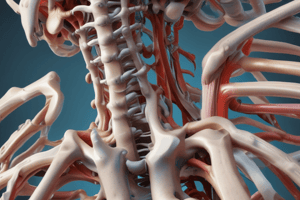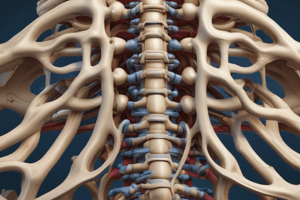Podcast
Questions and Answers
The laminae of a lumbar vertebra provide attachment to the multifidus and to the medial intertransverse muscles.
The laminae of a lumbar vertebra provide attachment to the multifidus and to the medial intertransverse muscles.
False (B)
A lumbar vertebra ossifies from five primary centers.
A lumbar vertebra ossifies from five primary centers.
False (B)
The concave articular facets of a lumbar vertebra permit only flexion and extension.
The concave articular facets of a lumbar vertebra permit only flexion and extension.
False (B)
The spine provides attachment to the erector spinae, the multifidus, and the interspinal muscles.
The spine provides attachment to the erector spinae, the multifidus, and the interspinal muscles.
Lumbar spinal stenosis results in an enlarged vertebral foramen.
Lumbar spinal stenosis results in an enlarged vertebral foramen.
Excessive Lumbar Lordosis is characterized by posterior tilting of the pelvis.
Excessive Lumbar Lordosis is characterized by posterior tilting of the pelvis.
The neural arch of a lumbar vertebra fuses with the body during the third month of foetal life.
The neural arch of a lumbar vertebra fuses with the body during the third month of foetal life.
Spina bifida results from the failure of the fusion of the two halves of the neural arch.
Spina bifida results from the failure of the fusion of the two halves of the neural arch.
The nuchal ligament is located in the lumbar spine.
The nuchal ligament is located in the lumbar spine.
The iliolumbar ligaments are fan-like ligaments radiating from the transverse processes of the L5 vertebra to the ilia of the pelvis.
The iliolumbar ligaments are fan-like ligaments radiating from the transverse processes of the L5 vertebra to the ilia of the pelvis.
The anterior and posterior longitudinal ligaments attach to the upper and lower borders of the lumbar vertebrae.
The anterior and posterior longitudinal ligaments attach to the upper and lower borders of the lumbar vertebrae.
The right crus of the diaphragm is attached to the upper four vertebrae.
The right crus of the diaphragm is attached to the upper four vertebrae.
The psoas major muscle originates from the anterior surface of the lumbar vertebrae.
The psoas major muscle originates from the anterior surface of the lumbar vertebrae.
The lumbar vessels pass above the tendinous arches.
The lumbar vessels pass above the tendinous arches.
The conus medullaris is located in the vertebral canal formed by the lower three lumbar vertebrae.
The conus medullaris is located in the vertebral canal formed by the lower three lumbar vertebrae.
The spinal meninges are only found in the vertebral canal formed by the first lumbar vertebra.
The spinal meninges are only found in the vertebral canal formed by the first lumbar vertebra.
The anterior edge of the body of the first sacral vertebra gives attachment to the middle fibres of the anterior longitudinal ligament.
The anterior edge of the body of the first sacral vertebra gives attachment to the middle fibres of the anterior longitudinal ligament.
The lamina of the first sacral vertebra provide attachment to the lowest pair of ligament flava.
The lamina of the first sacral vertebra provide attachment to the lowest pair of ligament flava.
The rough part of the ala gives origin to the iliacus posteriorly.
The rough part of the ala gives origin to the iliacus posteriorly.
The dorsal surface of the sacrum gives origin to the erector spinae along a straight line.
The dorsal surface of the sacrum gives origin to the erector spinae along a straight line.
The interosseous sacroiliac ligament is attached to the smooth area of the lateral surface behind the auricular surface.
The interosseous sacroiliac ligament is attached to the smooth area of the lateral surface behind the auricular surface.
The lower narrow part of the lateral surface of the sacrum gives origin to the gluteus maximus and attachment to the sacrotuberous and sacrospinous ligaments.
The lower narrow part of the lateral surface of the sacrum gives origin to the gluteus maximus and attachment to the sacrotuberous and sacrospinous ligaments.
The sympathetic chain is related to the rough part of the ala.
The sympathetic chain is related to the rough part of the ala.
The median sacral vessels are related to the dorsal surface of the sacrum.
The median sacral vessels are related to the dorsal surface of the sacrum.
Flashcards are hidden until you start studying
Study Notes
Ligaments of the Spine
- The nuchal ligament is formed by the thickened interspinous and supraspinous ligaments in the cervical spine.
Unique Ligaments of the Lumbar Spine
- The lumbosacral joint (between L5 and S1 vertebrae) is strengthened by the iliolumbar ligaments, which are fan-like and radiate from the transverse processes of the L5 vertebra to the ilia of the pelvis.
Attachments and Relations of Lumbar Vertebrae
- The body of a lumbar vertebra provides attachment to intervertebral discs on its upper and lower surfaces.
- The upper and lower borders of the body give attachment to the anterior and posterior longitudinal ligaments in front and behind, respectively.
- The right crus of the diaphragm is attached to the upper three vertebrae, and the left crus to the upper two vertebrae, lateral to the anterior longitudinal ligament.
- Behind the line of the crura, the upper and lower borders of all lumbar vertebrae give origin to the psoas major.
- Tendinous arches are attached across the constricted part of the body on either side, and the lumbar vessels and the grey ramus communicans from the sympathetic chain pass deep to each of these arches.
- The neural canal formed by the first and second lumbar vertebrae contains the conus medullaris, and the part formed by the lower three vertebrae contains the cauda equina.
- The canal of all lumbar vertebrae contains the spinal meninges.
- The pedicles are related above and below to spinal nerves.
- The laminae provide attachment to the ligament flavum.
Articular Processes
- The concave articular facets permit some rotation as well as flexion and extension.
- The mammillary process gives attachment to the multifidus and to the medial intertransverse muscles.
Ossification
- A lumbar vertebra ossifies from three primary centers – one for the body or centrum and one each for each half of the neural arch.
- The two halves of the neural arch fuse with each other posteriorly during the first year.
- Fusion of the neural arch with posterolateral parts of the body develops from the center for the neural arch.
- There are seven secondary centers, including upper and lower annular epiphyses, one center for the tip of each transverse process, one center for each mammillary process, and one center for the tip of the spine.
Clinical Relevance
- Lumbar Spinal Stenosis is a hereditary condition that results in a stenotic (narrow) vertebral foramen in one or several lumbar vertebrae, causing compression of the spinal cord and exiting nerves.
- Excessive Lumbar Lordosis is an abnormal anterior curvature of the vertebral column in the lumbar region, characterized by anterior tilting of the pelvis.
Attachments on the Sacrum
- The anterior and posterior edges of the body of the first sacral vertebra give attachment to the lowest fibers of the anterior and posterior longitudinal ligaments.
- The lamina of this vertebra provide attachment to the lowest pair of ligament flava.
- The rough part of the ala gives origin to the iliacus anteriorly and attachment to the lumbosacral ligament posteriorly.
- The upper part of the ventral sacroiliac ligament is attached to its margin.
- The part of the pelvic surface lateral to the bodies of the middle three pieces of the sacrum gives origin to the piriformis.
- The dorsal surface gives origin to the erector spinae along a U-shaped line passing over the spinous and transverse tubercles.
- The area in the concavity of the “U” gives origin to the multifidus.
- The interosseous sacroiliac ligament is attached to the rough pitted area of the lateral surface behind the auricular surface.
- The lower narrow part of the lateral surface, below the auricular surface, gives origin to the gluteus maximus, attachment to the sacrotuberous and sacrospinous ligaments, and origin to the coccugeus, in that order from behind forwards.
- The inferior lateral angle gives attachment to the lateral sacrococcygeal ligament.
Relations of the Sacrum
- The smooth part of the ala is related to the sympathetic chain, the lumbosacral trunk, the iliolumbar artery, and the obturator nerve, which are overlapped by the psoas major muscle.
- The pelvic surface is related to the median sacral vessels in the median plane.
Studying That Suits You
Use AI to generate personalized quizzes and flashcards to suit your learning preferences.



